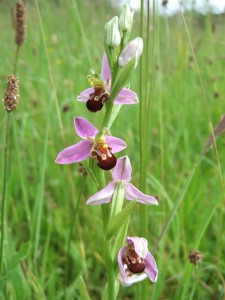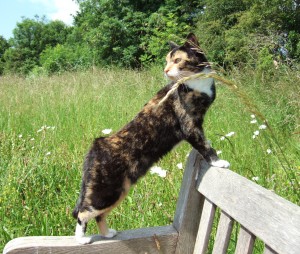The top part of our village allotments has been left as a small nature conservation area. About eight years ago I seeded it with a calcareous soil wildflower mix from Emorsgate Seeds, on behalf of our local conservation group. The area had been overgrown with rank grasses, which grew so strongly that other wildflowers were not able to get a proper foothold. In the seed mix was yellow rattle, a plant that parasitises the roots of neighbouring plants and so weakens them, and which is used as a natural method of controlling the rank grasses. It has been interesting watching the development of the meadow area. In the spring we get a fantastic show of cowslips, followed by black medic and yellow rattle and white and red clover and ox-eye daisies and all sorts of pretty flowers.
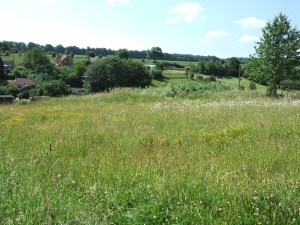
The conservation area of the allotments – a beautiful wildflower meadow, photographed this morning. If you click on the photo you can just make out a small clump of pyramidal orchids in the centre of the grassy area. The white drift behind them is a patch of ox-eye daisies (Leucanthemum vulgare).
Even before we sowed the seeds there were wild orchids growing on the allotments and in the conservation area: mainly pyramidal orchids, with a few bee orchids and a couple of common spotted ones. The orchids have ‘on’ years when they flower well, and ‘off’ years when they sulk and don’t bother to flower. This year is a ‘so-so’ year for the pyramidals, but there is no sign of the bee or the common spotted ones.
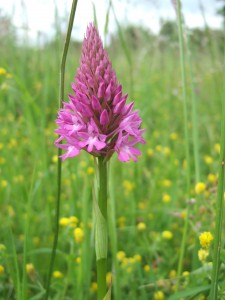
The well-named Pyramidal orchid (Anacamptis pyramidalis) on the allotments, 16 June 2008. Black medic (Medicago lupulina) lurking in the background.
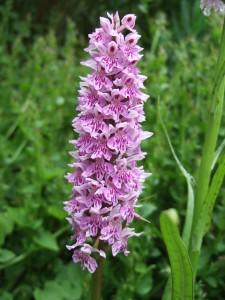
Common spotted orchid (Dactylorhiza fuchsii) in our garden, 14 June 2006. The spots on the leaves, from which it gets its name, are visible.
We went for a walk there this morning and Ballou came with us. She adores Chap and howled pathetically when he wandered out of sight. While we were up there we met Charlie, our neighbour, with one of his cats.
Despite its name, the common spotted orchid isn’t at all common in our conservation area. We have a lone specimen growing in our garden, bought from a favourite local nursery, Nadder Valley Nurseries (they don’t seem to have a website so I can’t link), many years ago.
